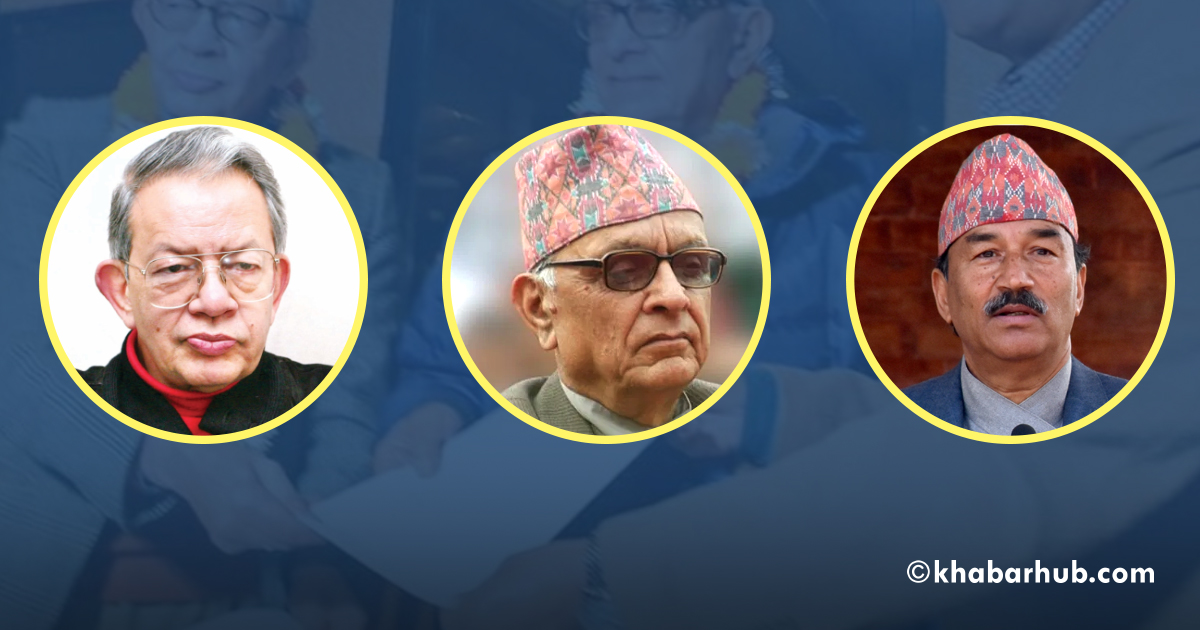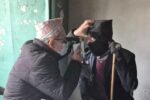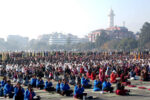KATHMANDU: It certainly wouldn’t be wrong to say politics is about power. Period. That’s why, the Rastriya Prajatantra Party (RPP) is currently close to its fifth unification bid with the realization that without reaching the helm or without getting united, a party can barely make an effect in politics.
RPP has a long list of troubling developments. And for RPP bigwigs like Kamal Thapa, Pashupati SJB Rana, and Dr Prakash Chandra Lohani – all Panchayat-era politicians – RPP is the raison d’etre in the first place.
Now that finding themselves to be weakened and battered, leaders at the helm of the party – Thapa, Rana, and Lohani – have agreed in principle to merge the party to become a ‘strong alternative political force’ at a time when people have started to talk about the need to explore a new political alternative.
However, no bombshells, this is the fifth time that the party is in the process of the merger since its formation in May 1990.
The reason why Rastriya Prajatantra Party (United) and Rastriya Prajatantra Party announced a merger after days of unification effort to become one is that they found themselves to be battered, sidelined or least bothered by the people.
Going back to its history, the party was initially formed by the ruling elites of the Panchayat era on May 29, 1990. However, RPP experienced its first split in 1991 to form RPP (Plough) and RPP (Cow) over technical differences between Surya Bahadur Thapa and Lokendra Bahadur Chand – both Panchayat stalwarts – with Thapa and Chanda heading each faction.
Not to be surprised, failing to win seats as expected in the 1991 elections, the two factions then merged again in 1992.
Accustomed to the pros and cons of split and unification, RPP leaders have often been compartmentalized as ‘opportunists’ as they have utterly failed to acknowledge people’s aspirations of change. To reiterate, it’s all about power politics.
In the wake of people’s frustration with the activities of the major political forces, there were suggestions from different quarters to explore the possibility of an alternative political force in the country – and RPP leaders lack the versatility.
To say it again, politics is about power, also a journey, and not a destination. This means that RPP leaders need to lower their expectations as they cannot deliver as despite having an active political presence in the country, the Nepal Communist Party (NCP) and Nepali Congress (NC) continue to dominate the modern Nepali political process.
The reason why Rastriya Prajatantra Party (United) and Rastriya Prajatantra Party announced a merger after days of unification effort to become one is that they found themselves to be battered, sidelined or least bothered by the people.
Does this mean that the latest move of the party big-wigs, accustomed to regular personality-clash, is nothing but yet another effort to unify? An absurd question, indeed! Let’s leave it to the future!
Now that, the party, whose major agendas include the establishment of a Sanatan Hindu State with a ceremonial monarch, is not unlikely to bear the brunt yet again as the unified RPP will have three party chiefs to decide on the central committee composition, division of responsibilities and day-to-day affairs of the party.
If anyone emphatically believes RPP will remain intact after the fifth unification, then the statement can be unfounded tenuous given the party’s history of splits, unification, and twists and turns.
Perhaps, young generation, who have little memory of party’s history, maybe losing their faith and interest in the party as the RPP leaders’, especially Kamal Thapa, who joined the KP Oli-led government in 2015 and Pushpa Kamal Dahal-led government in 2017 as Deputy Prime Minister as his lust for power tarnished his image contributing to apathy.
First split
Let’s talk about its history. The RPP formed by Panchayat-era Prime Ministers — Thapa and Chand – split for the first time in 1991 to merge again in 1992, held its first general convention in Kathmandu and unanimously elected Surya Bahadur Thapa as its chairman.
The party received 18 percent of the votes winning 20 seats to the House of Representatives in the 1994 elections, making RPP the third-largest party in the parliament.
Second split
The party split for the second time in 1997 after a faction led by Lokendra Bahadur Chand joined a coalition government with the then CPN-UML party with Chand as Prime Minister.
Meanwhile, the government was toppled with the joint effort of the Surya Bahadur Thapa-led faction and the then opposition Nepali Congress party. Chand stepped down to form his own party again.
Later, facing defeat in the 1999 elections, the two factions decided to merge again.
Meanwhile, after King Gyanendra Shah dismissed the Sher Bahadur Deuba-led government in October 2002, Chand was appointed Prime Minister. He, however, stepped down in May 2003. He was replaced by Surya Bahadur Thapa.
Third split
When Surya Bahadur Thapa retired as party Chairman after the third general convention in Pokhara in December 2002, RPP got Rana as its Chairman.
RPP split again in March 2005 when Thapa broke away to form the Rastriya Janashakti Party (RJP) calling for what he said ‘broader democratic alliance’.
Meanwhile, in May 2013, the Thapa-led RJP merged with the RPP, won 13 seats in the 2013 elections becoming the sixth largest party in the second Constituent Assembly.
On 21 November 2016, RPP Nepal led by Kamal Thapa and RPP announced unification. The RPP led by Thapa then had a total strength of 37 in the country’s Parliament to become the fourth largest party.
Fourth split
However, the RPP split again owing to differences in selecting the party’s electoral symbol. Dr. Lohani then formed a new party named the Unified Rastriya Prajatantra Party (Nationalist) on March 29, 2017.
Fifth split
The party saw yet another split after Pashupati SJB Rana formed the RPP (Democratic).
Now that the unified party’s declaration assembly will be held on March 11, it has decided to follow local self-governance, liberal economy, and non-aligned foreign policy.
A task force has been formed to determine further procedures of the unification, and an interim statute will be drafted and presented by a committee within the next six months.
However, the concern is the personality clash among Rana, Dr Lohani and Thapa will lead the party to yet another split.









Comment